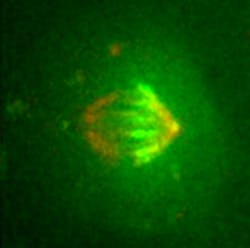Laser microscopy helps track key component of cell division
Using laser microscopy, two researchers at the Institute for Research in Biomedicine (IRB Barcelona) in Spain have discovered that the most abundant components of the mitotic spindle (a structure that assembles during cell division) are the microtubules. By labeling the ends of thousands of microtubules—which are fine filaments that are extremely dynamic and variable—the researchers have been able to follow their distribution and movement during the assembly of the mitotic spindle, according to Jens Lüders, a cell biologist from IRB Barcelona.
Related: Ultrafast laser enables cell study, with big implications
"For more than 10 years we have been able to track only the growing ends of microtubules, but not the starting points. As a result, we lacked essential information in order to understand the dynamic architecture of the mitotic spindle and how it contributes to cell division," says Lüders. Headed by the German scientist who runs the Microtubule Organisation Group at IRB Barcelona, the study carries only two names—his own and that of the French researcher Nicolas Lecland, first author of the study, who completed his PhD at IRB Barcelona through a "la Caixa" fellowship.
The scientists have demonstrated that the protein g-tubulin localizes at the starting points of the microtubule filaments and is relatively stably associated with these structures. Using a version of g-tubulin that carries a fluorescent label activated by laser light, the researchers were able to follow the movement of the starting points of microtubules within mitotic spindles by filming dividing human cells. The Advanced Digital Microscopy Facility, a joint IRB Barcelona-Barcelona Science Park Facility run by IRB physicist Julien Colombelli, has been crucial for setting up the technology required.
In their study, the researchers describe for the first time where most microtubules form inside the mitotic spindle, how they develop, and how their starting points are transported—with the help of three motor proteins—to opposite poles of the spindle, where they attach. Simultaneous to this process, the opposite ends of the filaments extend towards the cell center, where they interact with chromosomes. When the spindle is finally assembled, the microtubules pull the chromosomes to opposite poles and initiate the physical division of the cell. "We now have a more complete understanding of how the spindle assembles and functions and can use our novel marker for testing old and new hypotheses about underlying mechanisms," says Lüders.
In addition, the breakthrough paves the way to better understanding the mode of action of drugs that inhibit microtubules and that are used in chemotherapy. These kinds of drugs impede the mitotic spindle, thus preventing cell division and interfering with tumor growth.
In spite of the many years of clinical success of these treatments against cancer, little is known about how they impair spindle architecture and function. Although these drugs are highly efficient, they do not show the specificity desirable, as they also affect healthy dividing cells. In addition, they affect non-dividing cells such as neurons, in which microtubules also have important functions. "A better understanding of the differences in spindle organization between cancer and healthy cells and how they respond to microtubule-targeted drugs is essential in order to optimize treatments, for example, by identifying more specific drugs or new targets. This tool could be useful to achieve these objectives," states Lüders.
Full details of the work appear in the journal Nature Cell Biology; for more information, please visit http://dx.doi.org/10.1038/ncb2996.
-----
Don't miss Strategies in Biophotonics, a conference and exhibition dedicated to development and commercialization of bio-optics and biophotonics technologies!
Follow us on Twitter, 'like' us on Facebook, and join our group on LinkedIn
Subscribe now to BioOptics World magazine; it's free!


